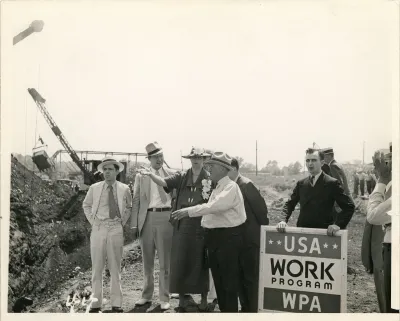Taking lessons from his time working in the Obama administration, President Biden is tempering promises of quick job creation with long-term reinvestment.

Learning from his experience as vice president, Joe Biden knows that "you can’t expect immediate results" when it comes to infrastructure spending and job creation, writes Jake Blumgart for Governing. "[H]istorically, public works projects have a complicated history when it comes to quickly getting a lot of people back to work." That makes infrastructure spending "bad stimulus spending" despite its long-term benefits.
The concept of "shovel-ready projects," a term popularized by President Obama in late 2008, proved deceptive. Research shows that in most areas of governance, "it took at least one year to set up a project and another two to three years to actually spend the money." Learning from these prior experiences, President Biden is taking a longer view. "The Biden administration’s rhetoric around the American Jobs Act is, obviously, about job creation. But the $2 trillion plan is not about juicing the economy in 2021, or even in the crucial midterm election year of 2022. Instead, it is meant to unfold over the course of a decade."
The public works programs of the New Deal era, according to Jason Scott Smith, assistant professor of history at the University of New Mexico, "are better understood not as unsuccessful state-employment measures, but rather as a strikingly effective method of state-sponsored economic development." By framing the American Jobs Act as long-term reinvestment, Biden is avoiding the "poor job of setting out expectations" that plagued the Obama administration.
FULL STORY: The Economic Lessons Biden Learned from Obama and Roosevelt

National Parks Layoffs Will Cause Communities to Lose Billions
Thousands of essential park workers were laid off this week, just before the busy spring break season.

Retro-silient?: America’s First “Eco-burb,” The Woodlands Turns 50
A master-planned community north of Houston offers lessons on green infrastructure and resilient design, but falls short of its founder’s lofty affordability and walkability goals.

Delivering for America Plan Will Downgrade Mail Service in at Least 49.5 Percent of Zip Codes
Republican and Democrat lawmakers criticize the plan for its disproportionate negative impact on rural communities.

Test News Post 1
This is a summary

Test News Headline 46
Test for the image on the front page.

Balancing Bombs and Butterflies: How the National Guard Protects a Rare Species
The National Guard at Fort Indiantown Gap uses GIS technology and land management strategies to balance military training with conservation efforts, ensuring the survival of the rare eastern regal fritillary butterfly.
Urban Design for Planners 1: Software Tools
This six-course series explores essential urban design concepts using open source software and equips planners with the tools they need to participate fully in the urban design process.
Planning for Universal Design
Learn the tools for implementing Universal Design in planning regulations.
EMC Planning Group, Inc.
Planetizen
Planetizen
Mpact (formerly Rail~Volution)
Great Falls Development Authority, Inc.
HUDs Office of Policy Development and Research
NYU Wagner Graduate School of Public Service



























